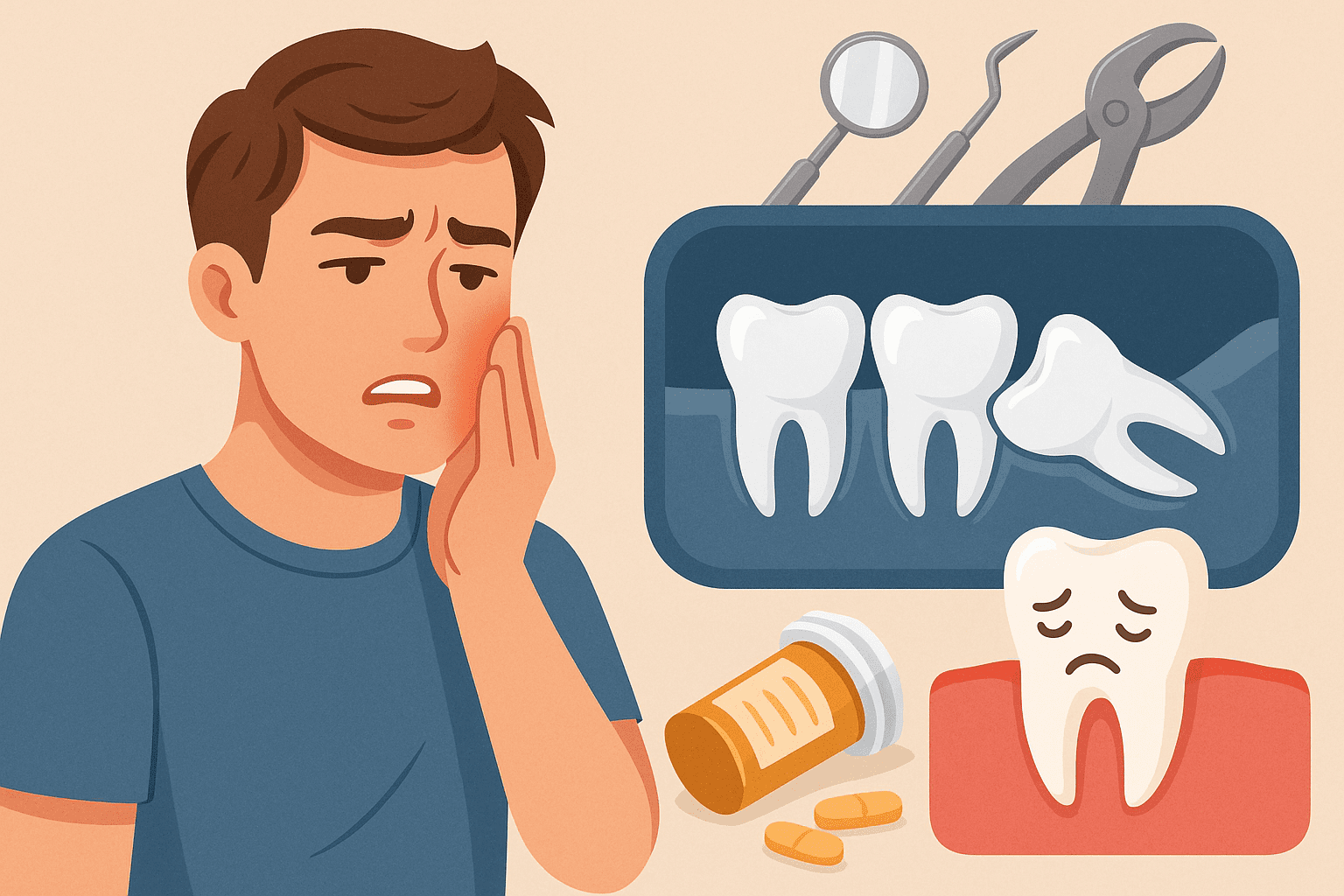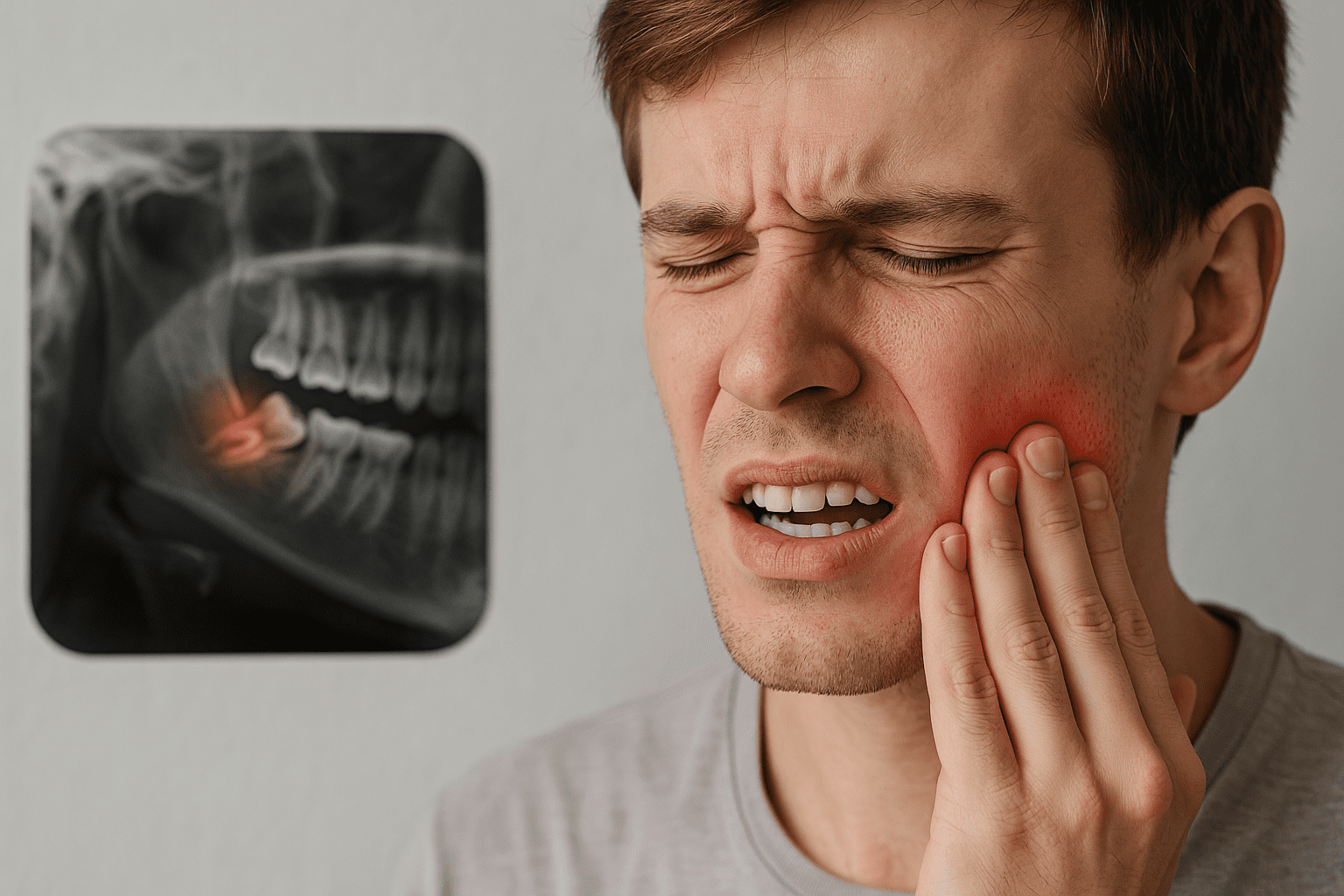Are your wisdom teeth acting up? Wondering if it’s time to plan a wisdom teeth extraction in Montreal? In this guide, we cover the key warning signs, how 3D CBCT planning boosts safety, your sedation options for a low-stress visit, plus concrete tips to prevent dry socket and a day-by-day recovery roadmap.
Red flags: when to book an assessment
Watch for these warning signs—each justifies a prompt evaluation:
- Recurring pain at the back of the jaw (often behind the second molar).
- Swollen, red gums or bad breath → possible pericoronitis.
- Cavities on the wisdom tooth or the neighbouring second molar (hard to clean).
- Cyst or lesion seen on imaging.
- Lack of space / impacted tooth causing teeth to shift.
- Pressure sensation, pain on opening, or sinus symptoms (upper wisdom teeth).
Even without pain, an impacted or poorly positioned wisdom tooth can silently damage the second molar. An exam helps determine the optimal timing for removal.
3D planning (CBCT): safer and more predictable
3D radiography (CBCT) precisely maps:
- root position,
- the inferior alveolar nerve (lower jaw),
- the maxillary sinus (upper jaw),
- root shape and angulation.
This 3D planning helps to:
- choose the most predictable extraction technique,
- shorten surgical time,
- reduce risks (e.g., nerve injury, sinus exposure),
- anticipate recovery needs and sedation choices.
Sedation and anaesthesia options in Montreal
Depending on your anxiety level and case complexity, options include:
- Local anaesthesia: the area is completely numb; you remain awake.
- Nitrous oxide (“laughing gas”): reduces anxiety; quick recovery.
- Oral sedation (medication): you stay conscious but more relaxed.
- IV sedation: deeper relaxation with continuous monitoring.
We’ll discuss each option at your consultation, considering your medical history and safety recommendations.
How the extraction works: step by step
- Pre-op
- Medical review, consent, CBCT/X-rays.
- Personalized instructions (e.g., fasting for certain sedation types).
- Anaesthesia + sedation (if needed)
- Comfort is tested before starting.
- Surgery
- Small incision if impacted; minimal bone removal if needed.
- Controlled tooth sectioning (when appropriate), atraumatic extraction.
- Irrigation of the site, resorbable sutures in many cases.
- Immediate post-op
- Gauze for bleeding control.
- Written instructions; prescriptions for pain control/rinses if needed.

Preventing dry socket (alveolar osteitis)
Dry socket occurs when the blood clot dislodges too early. Reduce the risk by:
- Not smoking/vaping for at least 72 hours (ideally 1 week).
- Avoiding suction: no straws, no vigorous rinsing for the first 24 hours.
- Sleeping with your head elevated for 2–3 nights.
- Applying ice (10 minutes on / 10 minutes off) during the first 24–36 hours.
- Managing pain with acetaminophen/ibuprofen as directed by your dentist.
- Starting gentle salt-water rinses after 24 hours (if advised).
Red flag: pain that worsens after 2–3 days, bad taste, or odour → call the clinic.
Recovery: day-by-day guide
- Day 0 (surgery): mild to moderate bleeding, numbness. Rest, ice, and gauze. Warm (not hot) liquids, purées, yogurt.
- Day 1: manageable discomfort; begin gentle rinses if advised. Limit activity.
- Days 2–3: expect a peak in swelling/stiffness. Continue analgesics; soft diet (scrambled eggs, applesauce, very soft pasta).
- Days 4–5: swelling decreases, jaw mobility improves. Gradual return to non-physical tasks.
- Days 6–7: most patients return to work/school. Still avoid contact sports/heavy lifting if recommended.
- Week 2: soft tissues progressing well; sutures (if present) may dissolve/be removed as planned.
- Weeks 3–4: bone healing continues; very hard foods may still feel sensitive.
If anything feels off (worsening pain, fever, pronounced one-sided swelling), contact us.
Food, hygiene, and habits
- Favour: warm liquids, smoothies without a straw, purées, tender fish, tofu, very soft pasta.
- Avoid for 7 days: crunchy foods (chips, nuts, seeds), alcohol, very hot or carbonated drinks, straws.
- Hygiene: gentle brushing (avoid the extraction site for the first 24 hours), then brush carefully around it.
- Sleep: keep your head elevated with 2–3 pillows.
- Tobacco/vaping: abstain as long as possible (dry socket risk).
Costs, insurance, and paperwork
Costs vary with the number of teeth, degree of impaction, 3D imaging, and sedation type. We provide a detailed estimate and, if needed, receipts for your dental insurance.
Why choose Dentisterie Montréal?
- Comprehensive assessment with 3D CBCT imaging.
- Sedation options tailored to your comfort.
- Clear guidance to prevent dry socket and speed healing.
- A team trained for predictable extractions and attentive follow-up.
Ready to discuss wisdom teeth extraction in Montreal? Book an appointment or visit: Wisdom Teeth • Sedation • 3D Radiography.
FAQ – Wisdom teeth (Montreal)
Do I need to remove my wisdom teeth if they don’t hurt?
Not always. If they’re well positioned, easy to clean, and lesion-free on imaging, we can monitor. A consultation and, if needed, CBCT help decide.
How long does the surgery take?
Typically 20–60 minutes depending on the number and position of teeth. Total time in clinic is longer (preparation, sedation, instructions).
When can I return to work/school?
Often after 2–3 days for light duties. Allow up to 1 week if your job is physical or multiple teeth were removed.
Will it hurt?
With local anaesthesia (and sedation if chosen), you shouldn’t feel pain during the procedure. Afterwards, discomfort is usually well managed with recommended analgesics.
Do I need antibiotics?
Only case by case (active infection, risk factors). Your dentist will advise based on your situation.
Will I have stitches?
Sometimes resorbable sutures; sometimes they’re removed after 7–10 days. We’ll confirm your plan.

